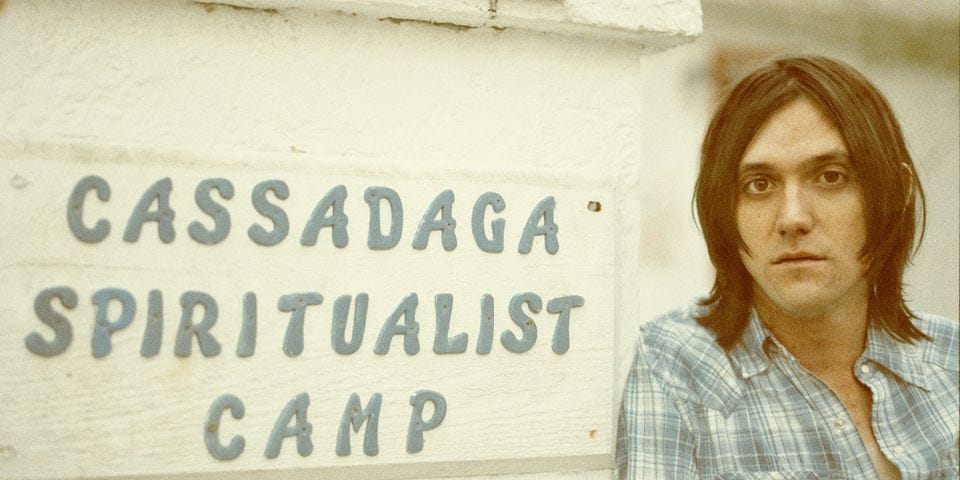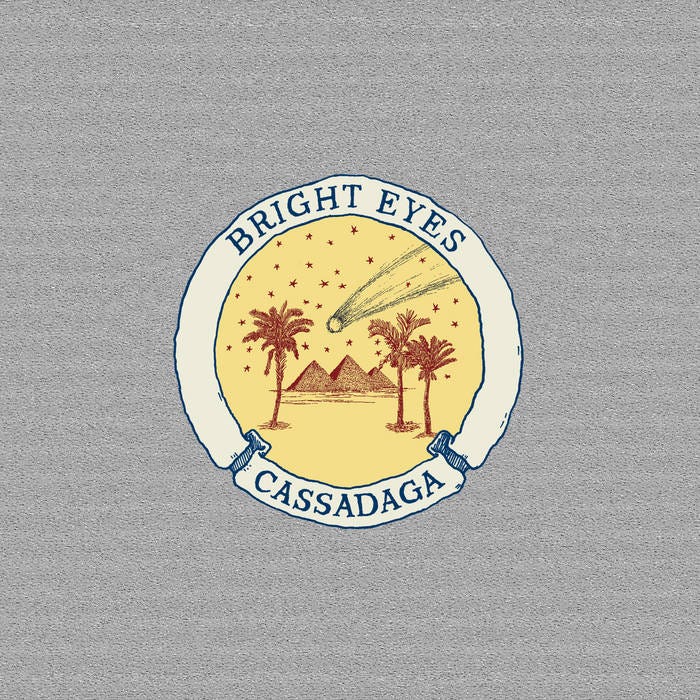Part 1: Clairaudients (Kill or Be Killed)
Part 2: Four Winds
Part 3: If the Brakeman Turns My Way
Part 4: Hot Knives
Part 5: Make a Plan to Love Me
“Writing about music is like dancing about architecture.” - Elvis Costello
Light scattered off the wick of a cream-colored candle, hanging a sweet but stale hue of vanilla on the air and throwing shadows in every direction of my bedroom. I stared at the CD I picked up from Hasting’s (RIP) days earlier. Why did I buy this? I asked myself. My expectations were more than tempered, even as my curiosity flickered. The shooting stars and swaying palm trees on the front cover sat against fuzzy TV static. A spectral decoder slipped out of the cover when I folded it open. I placed the decoder over the surface, revealing the phrase “water beneath the rocks” and a pair of pyramids, stirring up the realization that I was still pretty damn stoned. I set the disc into my stereo and plugged the quarter inch headphone jack into the outlet. I didn’t want to wake my parents.
An uneasy feeling settled over me. My skepticism of whatever this was remained potent. A year earlier, in the music section of my MySpace (RIP) page - hallowed grounds for a high schooler, circa 2007 - I wrote “anything but Bright Eyes.” A song on a burned CD re-opened my mind when these lines convinced me there was something special about this artist:
We'll keep working on the problem
We know we'll never solve
Of love's uneven remainders
Our lives are fractions of a whole
But if the world could remain within a frame
Like a painting on a wall
I think we'd see the beauty then
And we’d stand staring in awe
At our still lives posed
Like a bowl of oranges
Like a story told
By the fault lines and the soil
I set the headphones over my ears and hit play. My bloodshot eyes were perfectly in sync with the opening track of the record - a diatribe from a mystic giving painstaking instructions about where to find the vortexes and spiritual meccas sprinkled across America, soon washed out by overlapping crescendos of orchestral catastrophe reminiscent of the Beatles’ “A Day in the Life”. The chaotic opening sent my head spinning, building taut and hectic tension with such intensity that I nearly hit stop right then. I was not expecting this muddled mess. Why did I buy this? my mantra circled back. The dissonance thrashed and every sound collided. It was a panic attack in audio form. Then, all at once, each disparate note resolved into one, and the song settled into a lonely, thin guitar walking upwards with the delicacy of spider legs onto a precarious landing. “Cassadaga may just be a premonition of a place you’re going to visit” the mystic concluded. A melody, in the territory of whispers made its place:
Corporate or colonial
The movement is unstoppable
Like the body of a centerfold
It spreads
To the counterculture copyright
Get your revolution at a lower price
Or make believe and throw the fight
Play dead
This record, I knew right then, was aiming for something much bigger than I imagined.

I am excited to announce a new project, “A Thick Mist of Change”, that will traverse, unearth, and celebrate what might be my favorite record: Cassadaga by Bright Eyes. If I’m honest, the origins of this project lie in an instinct to defend the album. When it came out, most critics failed to grapple with it on its own terms, and some fans of the band hoped for a re-creation of what had come before. I blissfully knew nothing of this at the time and assumed it was a universally acclaimed masterpiece that changed music forever. I didn’t bother to check with the rest of the world and figured it must have won every Grammy (I was right about this in one unexpected way - it did win a Grammy for its album art with the spectral decoder).
Riding a wave of popular and critical success following the release of the ambitious dual release of I’m Wide Awake It’s Morning and Digital Ash in a Digital Urn, Bright Eyes embarked on the band’s most ambitious effort yet. While Wide Awake and Digital Ash illustrated the musical and lyrical range of the band, that depth was neatly parsed, portioning the revelations of a small town kid named Conor Oberst moving to a big city in a stripped down folk record and the abstract existential dread of that same person in an electro-tinged rock record. Cassadaga invites every tension into the tent, blending Americana with a mystic soundscape while weaving together vignettes into overarching themes that speak equally to the times and the most foundational questions of existence. Complex characters occupy the recognizable but surreal reality of the modern world, sometimes undergoing profound transformations and other times accepting the trap of circumstance.
Every song on Cassadaga is its own self-contained world, but you can see the stitches of the universe it weaves together as a complete work. I love the album for its ambition; for its grounded Americana unleashed into flourishes of cinematic grandiosity; for its self-aware sonic and lyrical spiritualism that marvels at belief itself; for its characters that rise and fall in many unique flavors of apocalypse; and for its freewheeling journey across a country haunted equally by its history and future. Every song has a string of lines or a turn of phrase that leaves me in awe. Most have more than a few. A parade of modern folk heroes from M. Ward to Gillian Welch to Jake Bellows make appearances, but the album is made cohesive and sonically rich through the dazzling production and creativity of Mike Mogis and Nate Walcott, two of the other pillars of the band.
Over the years, I picked up on some of the negativity that seemed to buzz around Cassadaga. Too grandiose. Too polished. Not visceral enough. All over the place. And why is he singing about cauliflower in a casserole? I paid it little mind. But in 2022 I was listening to Justin Cox’s fantastic podcast After the Deluge, which takes a deep dive into the entire catalogue of an artist. The Bright Eyes season is excellent, but when I got to the Cassadaga episode, I had more than one “outloud” reaction to one of the episode’s guests, who not-so-generously reviewed the album for Pitchfork when it was released. Since then, I’ve had in the back of my head that I want to set about some sort of project to give this album its due and to fully reckon with it as a work of art.
So here’s where I landed: In a series of essays collectively known as “A Thick Mist of Change”, I will review a song on Cassadaga every month for the next 13 months, exploring its lyrics and themes, soundscape, the musicians who contributed to the song, reflections from the artist, and the song’s place in the album.
I haven’t written much about music, so I am stretching outside my comfort zone a bit. I hope you’ll be more generous with me than the critics were with Cassadaga. I’ll kick off the project with the first song on the album, “Clairaudients (Kill or Be Killed)”, which is the song I described in the introduction. I’ll share that one here in the next week or two. I am so excited to share this project with friends, Bright Eyes fans, and newcomers to the band who love great songwriting. Thank you for coming along on the journey.
You can find the library of posts below:
Clairaudients (Kill or Be Killed) - May 2025
Four Winds - June 2025
If the Brakeman Turns My Way - July 2025
Hot Knives - August 2025
Make a Plan to Love Me - September 2025
Soul Singer in a Session Band - October 2025
Classic Cars - November 2025
Middleman - December 2025
Cleanse Song - January 2026
No One Would Riot for Less - February 2026
Coat Check Dream Song - March 2026
I Must Belong Somewhere - April 2026
Lime Tree - May 2026



I can’t wait to take this journey with you, Colin! This is beautiful and I have no doubt you’ll introduce me to a new favorite album. The passion is palpable and I’m ready to hear more!